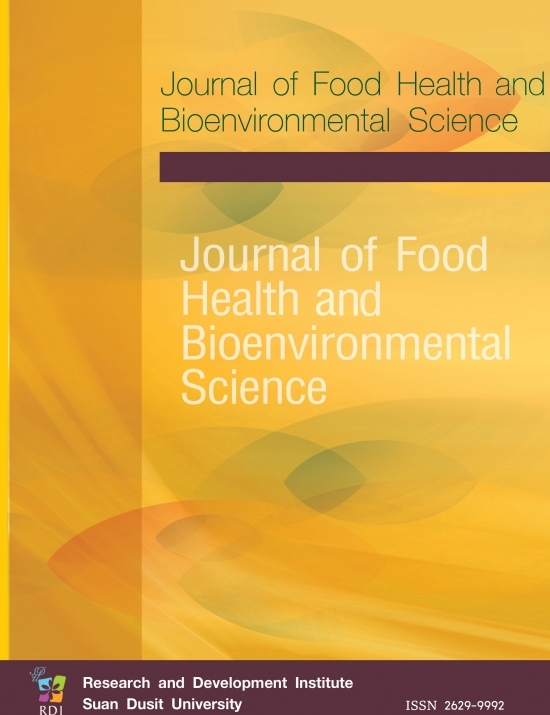Antimicrobial Activity of Edible Plant Extracts Against Skin Infection Pathogens
Keywords:
Edible Plant, Extract, Antimicrobial Activity, Skin Infection PathogensAbstract
Antimicrobial activity of four edible plant extracts including ginger, galangal, lemongrass and tree basil have been investigated. For this purpose, the extract of plants was acquired using ethanol and distilled water. The inhibitory effect on six skin infection pathogenic microorganisms, i.e., Escherichia coli, Staphylococcus aureus, Staphylococcus epidermidis, Pseudomonas aeruginosa, Propionibacterium acnes and Candida albicans were performed by disc diffusion, agar well diffusion and microdilution methods. From the results, ethanolic extract of galangal showed the best antimicrobial activities against all test pathogens in terms of the minimum inhibitory concentration and minimum bactericidal concentration, ranging from 0.49-15.62 mg/ml and 0.49-62.5 mg/ml, respectively. Therefore, the aqueous extract has lower antimicrobial activity compared with the ethanolic extract. The ethanolic extracts of ginger, galangal and lemongrass could inhibit P. acnes at the concentrations lower than 1 mg/ml. The outcome of this study suggested that edible plant extracts could possibly be applied as a natural antimicrobial agent and combined with other materials for further applications.
References
Bassolé, I.H.N., Lamien-Meda, A., Bayala, B.O.L.C., Obame, L.C., Ilboudo, A.J., Franz, C., ... & Dicko, M.H. (2011). Chemical composition and antimicrobial activity of Cymbopogon citratus and Cymbopogon giganteus essential oils alone and in combination. Phytomedicine, 18(12), 1070-1074. https://doi.org/10.1016/j.phymed.2011.05.009
Bauer, A.W., Kirby, W.M.M., Sherris, J.C., & Turck, M. (1966). Antibiotic susceptibility testing by a standardized single disk method. American Journal of Clinical Pathology, 45(4), 493–496. https://doi.org/10.1093/ajcp/45.4_ts.493
Clinical and Laboratory Standard Institute (CLSI). (2016). Performance standards for antimicrobial susceptibility testing M100S (26th ed.). Wayne, Pa, USA: Clinical and Laboratory Standards Institute.
Cohen, M.L. (1992). Epidemiology of drug resistance: implications for a post-antimicrobial era. Science, 257(5073), 1050-5.
Djeussi, D.E., Noumedem, J.A., Seukep, J.A., Fankam, A.G., Voukeng, I.K., Tankeo, S.B., ... & Kuete, V. (2013). Antibacterial activities of selected edible plants extracts against multidrug-resistant Gram-negative bacteria. BMC Complementary and Alternative Medicine, 13 (164), 1-8. https://doi.org/10.1186/1472-6882-13-164do
Nascimento Silva, M.K., Carvalho, V.R.D.A., & Matias, E.F.F. (2016). Chemical profile of essential oil of Ocimum gratissimum L. and evaluation of antibacterial and drug resistance-modifying activity by gaseous contact method. Pharmacognosy Journal, 8(1). 4-9.
Er, Y., Sivri, N., & Mirik, M. (2018). Antimicrobial activity of essential oil against Rhizobium (Agrobacterium) vitis using agar well and disc diffusion method. Bacteriology Journal, 8(1), 1–11. https://doi.org/10.3923/bj.2018.1.11
Farnsworth, N.R., & Bunyapraphatsara, N. (1992). Thai medicinal plants: Recommended for primary health care system. Bangkok: Mahidol University.
Gupta, D., Dubey, J., & Kumar, M. (2016). Phytochemical analysis and antimicrobial activity of some medicinal plants against selected common human pathogenic microorganisms. Asian Pacific Journal of Tropical Disease, 6(1), 15–20. https://doi.org/10.1016/S2222-1808(15)60978-1
Grzanna, R., Lindmark, L., & Frondoza, C.G. (2005). GingerAn herbal medicinal product with broad anti-inflammatory actions. Journal of medicinal food, 8(2), 125–132.
Hasan, H.A., Mohammed, A., Raauf, R., Monjd, B., Razik, A., Abdul, B., & Hassan, R. (2012). Chemical composition and antimicrobial activity of the crude extracts isolated from Zingiber officinale by different solvents. Pharmaceutica Analytica Acta, 3(9), 1-5. https://doi.org/10.4172/2153-2435.1000184
Hamad, A., Alifah, A., Permadi, A., & Hartanti, D. (2016). Chemical constituents and antibacterial activities of crude extract and essential oils of Alpinia galanga and Zingiber officinale. International Food Research Journal, 23(2), 837–841.
Junsathian, P., Yordtong, K., Corpuz, H.M., Katayama, S., Nakamura, S., & Rawdkuen, S. (2018). Biological and neuroprotective activity of Thai edible plant extracts. Industrial Crops and Products, 124, 548–554. https://doi.org/10.1016/j.indcrop.2018.08.008
Komutiban, O. (2014). Antioxidant activity of crude extracts from the heartwood of Aptocarpus lakoocha Roxb. SDU Research Journal, 7(2), 33-42.
Leesombun, A., Boonmasawai, S., & Nishikawa, Y. (2017). Effects of Thai piperaceae plant extracts on Neospora caninum infection. Parasitology International, 66(3), 219–226. https://doi.org/10.1016/j.parint.2017.01.017
Lipsky, B.A., Weigelt, J.A., Gupta, V., Killian, A., & Peng, M.M. (2007). Skin, soft tissue, bone, and joint infections in hospitalized patients: epidemiology and microbiological, clinical, and economic outcomes. Infection Control & Hospital Epidemiology, 28(11), 1290-1298. https://doi.org/10.1086/520743
Livermore, D.M., Mushtaq, S., Warner, M., James, D., Kearns, A., & Woodford, N. (2015). Pathogens of skin and skinstructure infections in the UK and their susceptibility to antibiotics, including ceftaroline. Journal of Antimicrobial Chemotherapy, 70(10), 2844–2853. https://doi.org/10.1093/jac/dkv179
Mayachiew, P., & Devahastin, S. (2008). Antimicrobial and antioxidant activities of Indian gooseberry and galangal extracts. LWT - Food Science and Technology, 41(7), 1153–1159. https://doi.org/10.1016/j.lwt.2007.07.019
Meeprathom, N.N., Jongrattanavit, K., & Kooprasertying, P. (2018). Proximate compositions, phenolic compounds, antioxidant capacity and antibacterial activity of chulta (Dillenia indica Linn.) fruits: effects of maturity stage and extraction solvent. Journal of Food Health and Bioenvironmental Science, 11(1), 57–78.
Noumedem, J.A.K., Lacmata, S.T., Kuiate, J.R., Kuete, V., Mihasan, M., & Stefan, M. (2013). Antibacterial activities of the methanol extracts of ten Cameroonian vegetables against Gram-negative multidrug-resistant bacteria. BMC Complementary and Alternative Medicine, 13(26), 1-9. https://doi.org/10.1186/1472-6882-13-26
Oonmetta-aree, J., Suzuki, T., Gasaluck, P., & Eumkeb, G. (2006). Antimicrobial properties and action of galangal (Alpinia galanga Linn.) on Staphylococcus aureus. LWT - Food Science and Technology, 39(10), 1214- 1220. https://doi.org/10.1016/j.lwt.2005.06.015
Parekh, J., & Chanda, S. (2011). Antibacterial and phytochemical studies on twelve species of Indian medicinal plants. African Journal of Biomedical Research, 10(2), 175- 181. https://doi.org/10.4314/ajbr.v10i2.50624
Santin, M.R., Oliveira, A., Cristina, I., Ferreira, P., & Uedanakamura, T. (2009). In vitro activity of the essential oil of Cymbopogon citratus and its major component (citral) on Leishmania amazonensis. Parasitology Research, 105, 1489–1496. https://doi.org/10.1007/s00436-009-1578-7
Sritubtim, S., Krapeedeang, S., & Wongsa, N. (2014). Biological activities on growth inhibition of bacteria of medicinal plant extracts from plants found in the upper Northeastern Thailand. SDU Research Journal, 7(1), 21–40.
Tan, B.K.H., & Vanitha, J. (2004). Immunomodulatory and antimicrobial effects of some traditional Chinese medicinal herbs: A review. Current Medicinal Chemistry, 11, 1423-1430.
Teanpaisan, R., Kawsud, P., Pahumunto, N., & Puripattanavong, J. (2017). Screening for antibacterial and antibiofilm activity in Thai medicinal plant extracts against oral microorganisms. Journal of Traditional and Complementary Medicine, 7(2), 172–177. https://doi.org/10.1016/j.jtcme.2016.06.007
Vora, J., Srivastava, A., & Modi, H. (2018). Antibacterial and antioxidant strategies for acne treatment through plant extracts. Informatics in Medicine Unlocked, 13, 128-132. https://doi.org/10.1016/j.imu.2017.10.005
Downloads
Published
How to Cite
Issue
Section
License

This work is licensed under a Creative Commons Attribution-NonCommercial-NoDerivatives 4.0 International License.








